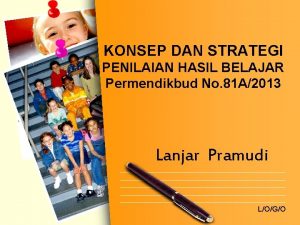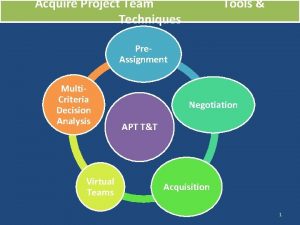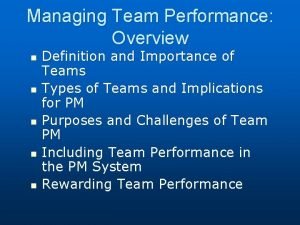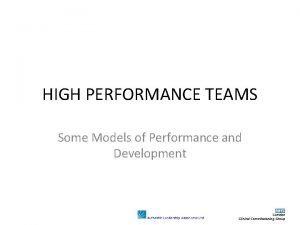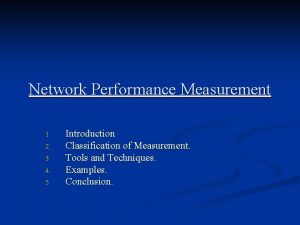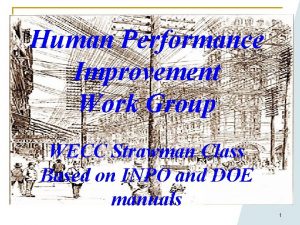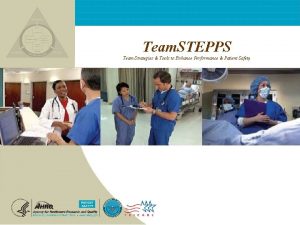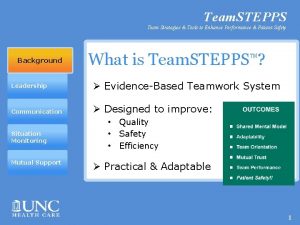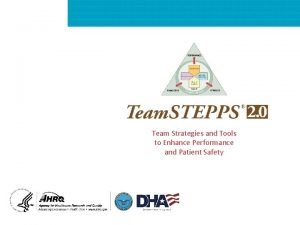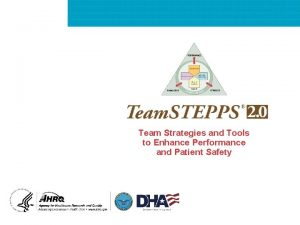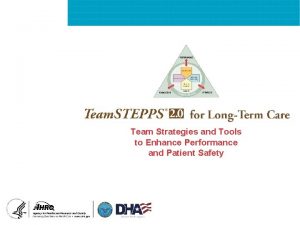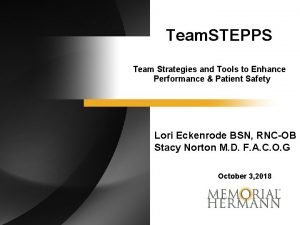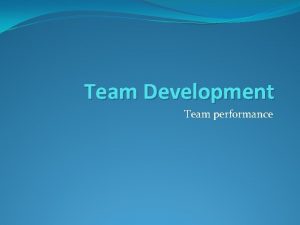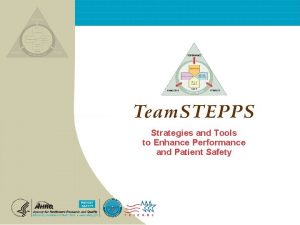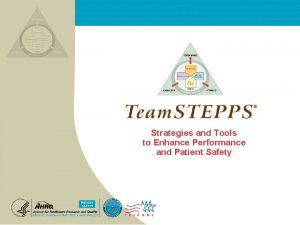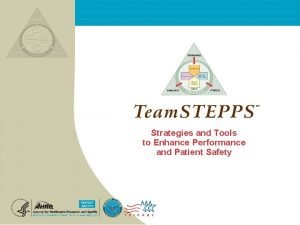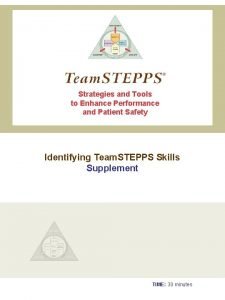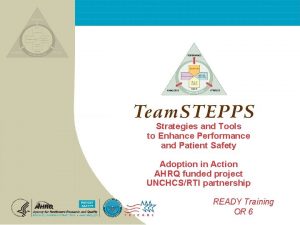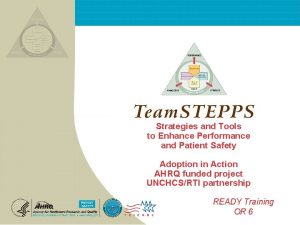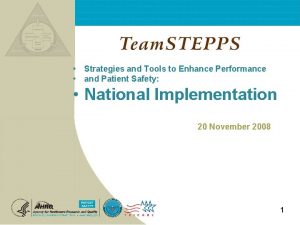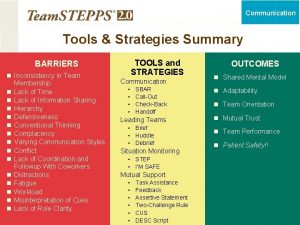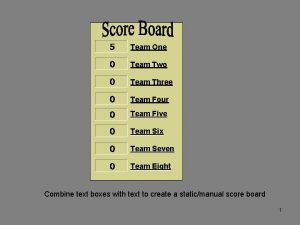Team Strategies and Tools to Enhance Performance and


































- Slides: 34

Team Strategies and Tools to Enhance Performance and Patient Safety Quality Improvement Leaders January 26, 2015

Introduction Goals of presentation Mod 1 06. 2 05. 2 Page 2 n Become familiar with the use teamwork fundamentals and tools of Team. STEPPS n Provide a practice environment for teamwork improvement in your core teams n Provide a practice environment and strategies for improving teamwork between QI teams and departments TEAMSTEPPS 05. 2 2

Introduction Survey Results Overall I’m satisfied with my knowledge of teamwork tools and strategies & when to use them WITHIN my QI workgroup/departm ent. Mod 1 06. 2 05. 2 Page 3 We work well as a team WITHIN my QI workgroup/ department. We have opportuniti es to improve the level of teamwork WITHIN my QI workgroup /departme nt. TEAMSTEPPS 05. 2 We have opportunities to improve the level of teamwork ACROSS QI workgroups/departments. We demonstrate good teamwork ACROSS QI workgroups/depart ments. 3

Introduction Survey Results Please share a successful teamwork example and the tools/techniques that were employed Please share an example of a time in which your team didn't work so well together and what opportunities you saw for improvement Mod 1 06. 2 05. 2 Page 4 TEAMSTEPPS 05. 2 4

Introduction Fundamentals Mod 1 06. 2 05. 2 Page 5 n Leadership n Situation Awareness n Mutual Support n Communication TEAMSTEPPS 05. 2 5

Introduction Why Errors Occur n Workload fluctuations courtesy n Interruptions n Fatigue n Halo effect n Multi-tasking n Passenger syndrome n Failure to follow up n Hidden agenda n Poor handoffs n Complacency n Ineffective n High-risk phase communication n Strength of an idea n Not following protocol Mod 1 06. 2 05. 2 Page 6 n Excessive professional TEAMSTEPPS 05. 2 n Task (target) fixation 6

Introduction Mod 1 06. 2 05. 2 Page 7 TEAMSTEPPS 05. 2 7

Introduction JAMA, October 20, 2010—Vol 304, No. 15 Mod 1 06. 2 05. 2 Page 8 TEAMSTEPPS 05. 2 8

Introduction W. Edward Deming Mod 1 06. 2 05. 2 Page 9 TEAMSTEPPS 05. 2 "What we need to do is learn to work in the system, by which I mean that everybody, every team, every platform, every division, every component is there not for individual competitive profit or recognition, but for contribution to the system as a whole on a win-win basis. " 9

5 Dysfunctions of a Team Introduction Patrick Lencioni Mod 1 06. 2 05. 2 Page 10 TEAMSTEPPS 05. 2 10

Introduction Mod 1 06. 2 05. 2 Page 11 TEAMSTEPPS 05. 2 11

Leadership

Introduction Effective Team Leaders n Organize the team n Articulate clear goals n Make decisions through collective input of members n Empower members to speak up and challenge, when appropriate n Skillful at conflict resolution Mod 1 06. 2 05. 2 Page 13 TEAMSTEPPS 05. 2 13

Team Events n Briefs – planning n Huddles – problem solving n Debriefs – process improvement Leaders are responsible to assemble the team and facilitate team events But remember… Anyone can request a brief, huddle, or debrief 14

Introduction Brief n During the brief, the team should address the following questions: n Who is on the team? n Do all members understand agree upon goals? n Are roles and responsibilities understood? n What is our plan? n What is staff's availability? n How is workload shared among team members? n What resources are available? Mod 1 06. 2 05. 2 Page 15 TEAMSTEPPS 05. 2 15

Introduction Huddle Problem solving Mod 1 06. 2 05. 2 Page 16 n Hold ad hoc, “touch-base” meetings to regain situation awareness n Discuss critical issues and emerging events TEAMSTEPPS 05. 2

Introduction Debriefs should be conducted for the following reasons: Mod 1 06. 2 05. 2 Page 17 n So team collectively learns from actual situations n So teams can improve performance n Valuable time to reinforce and recognize good teamwork behavior TEAMSTEPPS 05. 2 17

Introduction Debriefs What went well? What didn’t go so well? What can we do better next time? Mod 1 06. 2 05. 2 Page 18 TEAMSTEPPS 05. 2 18

Introduction PRACTICE IN SMALL GROUPS Mod 1 06. 2 05. 2 Page 19 TEAMSTEPPS 05. 2 19

Introduction SITUATION MONITORING Mod 1 06. 2 05. 2 Page 20 TEAMSTEPPS 05. 2 20

Introduction Situation Monitoring Process 1. Situation Awareness (Individual Outcome) Situation Monitoring (Skill) 2. Shared Mental Models (Team Outcome) 3. Mod 1 06. 2 05. 2 Page 21 TEAMSTEPPS 05. 2 21

Introduction Situation Monitoring Mod 1 06. 2 05. 2 Page 22 n Cross Monitoring n I’M SAFE – ask for assistance – “watch my back” TEAMSTEPPS 05. 2 22

Introduction How to Foster a Shared Mental Model n Routinely update others n Acknowledge deviations or changes in the situation n Alert team to actual or potential problems n Verbalize a course of action n Request needed information when uncertain Mod 1 06. 2 05. 2 Page 23 TEAMSTEPPS 05. 2 23

Introduction DISCUSS USE IN OUR AREAS Mod 1 06. 2 05. 2 Page 24 TEAMSTEPPS 05. 2 24

Communication

Introduction Check Back Sender verifies that the message was received Receiver accepts the message and provides feedback confirmation Sender initiates the message Mod 1 06. 2 05. 2 Page 26 TEAMSTEPPS 05. 2 26

Introduction Callout n A strategy used to communicate important information. n It informs all team members simultaneously n It helps team members anticipate next steps n In your work situations, what information would you want called out? Mod 1 06. 2 05. 2 Page 27 TEAMSTEPPS 05. 2 27

Introduction SBAR-Q n Situation n Background n Assessment n Recommendations n Questions? Mod 1 06. 2 05. 2 Page 28 TEAMSTEPPS 05. 2 28

Introduction Critical Language (“CUS”) n. Concerned (I’m concerned about …) n. Uncomfortable (I’m uncomfortable proceeding without…) n. Safety (I don’t think it’s safe to…) Mod 1 06. 2 05. 2 Page 29 TEAMSTEPPS 05. 2 29

Introduction MUTUAL SUPPORT Mod 1 06. 2 05. 2 Page 30 TEAMSTEPPS 05. 2 30

Introduction Mutual Support n Protects team members from work overload situations n Help your fellow teammates by offering assistance n Task Assistance n Feedback n Advocacy and Assertion Mod 1 06. 2 05. 2 Page 31 TEAMSTEPPS 05. 2 31

Introduction DESC Script n D—Describe the specific situation or behavior; provide concrete data. n E—Express how the situation makes you feel/what your concerns are. n S—Suggest other alternatives and seek agreement. n C—Consequences should be stated in terms of impact on established team goals; strive for consensus. Mod 1 06. 2 05. 2 Page 32 TEAMSTEPPS 05. 2 32

Introduction Two Challenge Rule n When an initial assertive statement is ignored: It is your responsibility to assertively voice concern at least two times to ensure that it has been heard. n The team member being challenged must acknowledge that concern has been heard. n If the safety issue still hasn't been addressed: Mod 1 06. 2 05. 2 Page 33 n Take a stronger course of action. n Utilize supervisor or chain of command. TEAMSTEPPS 05. 2 33

Introduction Goals of presentation Mod 1 06. 2 05. 2 Page 34 n Become familiar with the use teamwork fundamentals and tools of Team. STEPPS n Provide a practice environment for teamwork improvement in your core teams n Provide a practice environment and strategies for improving teamwork between QI teams and departments TEAMSTEPPS 05. 2 34
 Grammar to enrich and enhance writing
Grammar to enrich and enhance writing A particular or unique version of a style is a
A particular or unique version of a style is a Enhance an image
Enhance an image A new backbone that can enhance learning capability of cnn
A new backbone that can enhance learning capability of cnn Cosmetics are substances that are used to enhance……..
Cosmetics are substances that are used to enhance…….. Enhance an image
Enhance an image Nyjc subject combination
Nyjc subject combination Enhance life
Enhance life Salad that stimulate appetite
Salad that stimulate appetite Nnn hypnosis
Nnn hypnosis Strategi penilaian pembelajaran
Strategi penilaian pembelajaran Team problem solving strategies
Team problem solving strategies Pre assignment
Pre assignment Going native project management
Going native project management Team spirit becomes team infatuation
Team spirit becomes team infatuation The white team cheers for the blue team, just like
The white team cheers for the blue team, just like Ipcr qet
Ipcr qet Team performance definition
Team performance definition Team performance models
Team performance models Sewing tools measuring tools
Sewing tools measuring tools Oracle tuning tutorial
Oracle tuning tutorial Network performance measurement tools
Network performance measurement tools Siebel monitoring
Siebel monitoring Network performance measurement tools
Network performance measurement tools Star error prevention tool
Star error prevention tool Performance engineering tools
Performance engineering tools Bars performance appraisal
Bars performance appraisal Performance management vs performance appraisal
Performance management vs performance appraisal 2018 jcids manual
2018 jcids manual Translation loss is *
Translation loss is * New product development and product life cycle strategies
New product development and product life cycle strategies Security strategies in windows platforms and applications
Security strategies in windows platforms and applications Security strategies in windows platforms and applications
Security strategies in windows platforms and applications Kind of reading
Kind of reading Chapter 17 promotional concepts and strategies answer key
Chapter 17 promotional concepts and strategies answer key










